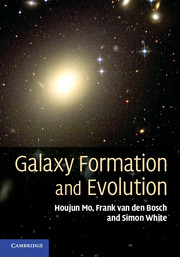Book contents
- Frontmatter
- Contents
- Preface
- 1 Introduction
- 2 Observational Facts
- 3 Cosmological Background
- 4 Cosmological Perturbations
- 5 Gravitational Collapse and Collisionless Dynamics
- 6 Probing the Cosmic Density Field
- 7 Formation and Structure of Dark Matter Halos
- 8 Formation and Evolution of Gaseous Halos
- 9 Star Formation in Galaxies
- 10 Stellar Populations and Chemical Evolution
- 11 Disk Galaxies
- 12 Galaxy Interactions and Transformations
- 13 Elliptical Galaxies
- 14 Active Galaxies
- 15 Statistical Properties of the Galaxy Population
- 16 The Intergalactic Medium
- A Basics of General Relativity
- B Gas and Radiative Processes
- C Numerical Simulations
- D Frequently Used Abbreviations
- E Useful Numbers
- References
- Index
11 - Disk Galaxies
Published online by Cambridge University Press: 05 June 2012
- Frontmatter
- Contents
- Preface
- 1 Introduction
- 2 Observational Facts
- 3 Cosmological Background
- 4 Cosmological Perturbations
- 5 Gravitational Collapse and Collisionless Dynamics
- 6 Probing the Cosmic Density Field
- 7 Formation and Structure of Dark Matter Halos
- 8 Formation and Evolution of Gaseous Halos
- 9 Star Formation in Galaxies
- 10 Stellar Populations and Chemical Evolution
- 11 Disk Galaxies
- 12 Galaxy Interactions and Transformations
- 13 Elliptical Galaxies
- 14 Active Galaxies
- 15 Statistical Properties of the Galaxy Population
- 16 The Intergalactic Medium
- A Basics of General Relativity
- B Gas and Radiative Processes
- C Numerical Simulations
- D Frequently Used Abbreviations
- E Useful Numbers
- References
- Index
Summary
In the previous chapters we have discussed the various physical ingredients that play a role in galaxy formation, from the growth, collapse and virialization of dark matter halos, to the formation of stars out of the baryonic material that cools within these halos. In this chapter we combine all this information to examine the structure and formation of disk galaxies.
As we have seen in Chapter 2, disk galaxies in general consist of a disk component made up of stars, dust and cold gas (both atomic and molecular), a central bulge component, a stellar halo, and a dark halo. The disk itself reveals spiral arms and often - in roughly half of all cases - a central bar component. Any successful theory for the formation of disk galaxies has to be able to account for all these components. In addition, it should also be able to explain a variety of observational facts (see §2.3.3), the most important of which are:
Brighter disks are, on average, larger, redder, rotate faster, and have a smaller gas mass fraction.
Disk galaxies have flat rotation curves.
The surface brightness profiles of disks are close to exponential.
The outer parts of disks are generally bluer, and of lower metallicity than the inner parts.
- Type
- Chapter
- Information
- Galaxy Formation and Evolution , pp. 495 - 543Publisher: Cambridge University PressPrint publication year: 2010
- 1
- Cited by



